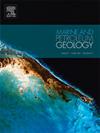Reproduction of channel stacking patterns in geomodeling: Metrics and impact of the modeling strategy on reservoir flow behavior
IF 3.7
2区 地球科学
Q1 GEOSCIENCES, MULTIDISCIPLINARY
引用次数: 0
Abstract
Channelized turbidite systems are often grouped into complexes and exhibit various stacking patterns, which play a crucial role in controlling the connectivity between high-permeability and low-permeability sedimentary bodies. While some studies have analyzed the static connectivity of different stacking patterns, few have quantitatively evaluated the dynamic implications of these patterns on fluid flow circulation at large scale, and no method have started to compare the outcome of different modeling methods. This study addresses this gap by quantitatively investigating the impact of different classes of geostatistical modeling methods on both static and dynamic connectivity using multiple metrics. Using an original object-based simulation method, we have stochastically generated 3 different stacking pattern sets of 100 realizations each with similar facies proportions, that represent: (i) disorganized channels, (ii) independent channels conditioned to a vertical sand proportion map, and (iii) organized stacking that reproduce vertical and lateral migration of channels. Channel internal heterogeneities are neglected and homogeneous properties are attached to the three main facies: channels, inner levees and outer levees. To analyze the hydrodynamic responses, we set up a two-phase system of oil and water. Reservoir simulations are performed for all 300 realizations, providing production curves, saturation field and pressure field. Classical dynamic metrics (breakthrough time and recovery efficiency) are completed by original ones, designed to understand what governs the differences between the sets: at 30% of the Pore Volume Injected, saturation front shapes are extracted and we compute their surface area and sphericity to get objective comparison criteria. Results reveal significant differences in flow behavior across the three studied sets of stacking models: Disorganized stacking patterns, and, to a smaller extent, the conditioned disorganized stacking patterns, exhibit delayed water breakthrough times and more optimistic recovery than organized stacking patterns, which have, however, a higher static connectivity. This unexpected result seems to be related to gravity-driven fluid segregation in the considered reservoir production settings. Overall, these results quantitatively confirm that the ability of the channel simulation method to generate realistic stacking pattern is essential. In addition, the lack of a clear relationship between static and dynamic connectivity metrics suggests the need for further research to develop more effective forecasting techniques for reservoir behavior in turbiditic channel settings.
求助全文
约1分钟内获得全文
求助全文
来源期刊

Marine and Petroleum Geology
地学-地球科学综合
CiteScore
8.80
自引率
14.30%
发文量
475
审稿时长
63 days
期刊介绍:
Marine and Petroleum Geology is the pre-eminent international forum for the exchange of multidisciplinary concepts, interpretations and techniques for all concerned with marine and petroleum geology in industry, government and academia. Rapid bimonthly publication allows early communications of papers or short communications to the geoscience community.
Marine and Petroleum Geology is essential reading for geologists, geophysicists and explorationists in industry, government and academia working in the following areas: marine geology; basin analysis and evaluation; organic geochemistry; reserve/resource estimation; seismic stratigraphy; thermal models of basic evolution; sedimentary geology; continental margins; geophysical interpretation; structural geology/tectonics; formation evaluation techniques; well logging.
 求助内容:
求助内容: 应助结果提醒方式:
应助结果提醒方式:


